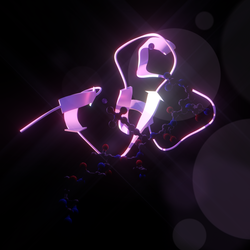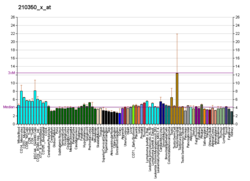ING1
ING1
Protein-coding gene in the species Homo sapiens
Inhibitor of growth protein 1 is a protein that in humans is encoded by the ING1 gene.[5][6][7]
| ING1 | |||||||||||||||||||||||||||||||||||||||||||||||||||
|---|---|---|---|---|---|---|---|---|---|---|---|---|---|---|---|---|---|---|---|---|---|---|---|---|---|---|---|---|---|---|---|---|---|---|---|---|---|---|---|---|---|---|---|---|---|---|---|---|---|---|---|
 | |||||||||||||||||||||||||||||||||||||||||||||||||||
| |||||||||||||||||||||||||||||||||||||||||||||||||||
| Identifiers | |||||||||||||||||||||||||||||||||||||||||||||||||||
| Aliases | ING1, p24ING1c, p33, p33p33ING1b, p47, p47ING1a, inhibitor of growth family member 1 | ||||||||||||||||||||||||||||||||||||||||||||||||||
| External IDs | OMIM: 601566 MGI: 1349481 HomoloGene: 40119 GeneCards: ING1 | ||||||||||||||||||||||||||||||||||||||||||||||||||
| |||||||||||||||||||||||||||||||||||||||||||||||||||
| |||||||||||||||||||||||||||||||||||||||||||||||||||
| |||||||||||||||||||||||||||||||||||||||||||||||||||
| |||||||||||||||||||||||||||||||||||||||||||||||||||
| |||||||||||||||||||||||||||||||||||||||||||||||||||
| Wikidata | |||||||||||||||||||||||||||||||||||||||||||||||||||
| |||||||||||||||||||||||||||||||||||||||||||||||||||
This gene encodes a tumor suppressor protein that can induce cell growth arrest and apoptosis. The encoded protein is a nuclear protein that physically interacts with the tumor suppressor protein TP53 and is a component of the p53 signaling pathway. Reduced expression and rearrangement of this gene have been detected in various cancers. Multiple alternatively spliced transcript variants encoding distinct isoforms have been reported.[7]
ING1 is located near the following genes on Chromosome 13
ING1 has been shown to interact with:
- "Human PubMed Reference:". National Center for Biotechnology Information, U.S. National Library of Medicine.
- "Mouse PubMed Reference:". National Center for Biotechnology Information, U.S. National Library of Medicine.
- Garkavtsev I, Demetrick D, Riabowol K (Jul 1997). "Cellular localization and chromosome mapping of a novel candidate tumor suppressor gene (ING1)". Cytogenetics and Cell Genetics. 76 (3–4): 176–8. doi:10.1159/000134539. PMID 9186514.
- Vieyra D, Loewith R, Scott M, Bonnefin P, Boisvert FM, Cheema P, Pastyryeva S, Meijer M, Johnston RN, Bazett-Jones DP, McMahon S, Cole MD, Young D, Riabowol K (Aug 2002). "Human ING1 proteins differentially regulate histone acetylation". The Journal of Biological Chemistry. 277 (33): 29832–9. doi:10.1074/jbc.M200197200. PMID 12015309.
- Xin H, Yoon HG, Singh PB, Wong J, Qin J (Mar 2004). "Components of a pathway maintaining histone modification and heterochromatin protein 1 binding at the pericentric heterochromatin in Mammalian cells". The Journal of Biological Chemistry. 279 (10): 9539–46. doi:10.1074/jbc.M311587200. PMID 14665632.
- Kuzmichev A, Zhang Y, Erdjument-Bromage H, Tempst P, Reinberg D (Feb 2002). "Role of the Sin3-histone deacetylase complex in growth regulation by the candidate tumor suppressor p33(ING1)". Molecular and Cellular Biology. 22 (3): 835–48. doi:10.1128/mcb.22.3.835-848.2002. PMC 133546. PMID 11784859.
- Garkavtsev I, Grigorian IA, Ossovskaya VS, Chernov MV, Chumakov PM, Gudkov AV (Jan 1998). "The candidate tumour suppressor p33ING1 cooperates with p53 in cell growth control". Nature. 391 (6664): 295–8. Bibcode:1998Natur.391..295G. doi:10.1038/34675. PMID 9440695. S2CID 4429461.
- Scott M, Bonnefin P, Vieyra D, Boisvert FM, Young D, Bazett-Jones DP, Riabowol K (Oct 2001). "UV-induced binding of ING1 to PCNA regulates the induction of apoptosis". Journal of Cell Science. 114 (Pt 19): 3455–62. doi:10.1242/jcs.114.19.3455. PMID 11682605.
- Campos EI, Chin MY, Kuo WH, Li G (Oct 2004). "Biological functions of the ING family tumor suppressors". Cellular and Molecular Life Sciences. 61 (19–20): 2597–613. doi:10.1007/s00018-004-4199-4. PMID 15526165. S2CID 28889915.
- Helbing CC, Veillette C, Riabowol K, Johnston RN, Garkavtsev I (Apr 1997). "A novel candidate tumor suppressor, ING1, is involved in the regulation of apoptosis". Cancer Research. 57 (7): 1255–8. PMID 9102209.
- Garkavtsev I, Riabowol K (Apr 1997). "Extension of the replicative life span of human diploid fibroblasts by inhibition of the p33ING1 candidate tumor suppressor". Molecular and Cellular Biology. 17 (4): 2014–9. doi:10.1128/mcb.17.4.2014. PMC 232048. PMID 9121449.
- Zeremski M, Horrigan SK, Grigorian IA, Westbrook CA, Gudkov AV (May 1997). "Localization of the candidate tumor suppressor gene ING1 to human chromosome 13q34". Somatic Cell and Molecular Genetics. 23 (3): 233–6. doi:10.1007/BF02721376. PMID 9330636. S2CID 24132112.
- Garkavtsev I, Grigorian IA, Ossovskaya VS, Chernov MV, Chumakov PM, Gudkov AV (Jan 1998). "The candidate tumour suppressor p33ING1 cooperates with p53 in cell growth control". Nature. 391 (6664): 295–8. Bibcode:1998Natur.391..295G. doi:10.1038/34675. PMID 9440695. S2CID 4429461.
- Shinoura N, Muramatsu Y, Nishimura M, Yoshida Y, Saito A, Yokoyama T, Furukawa T, Horii A, Hashimoto M, Asai A, Kirino T, Hamada H (Nov 1999). "Adenovirus-mediated transfer of p33ING1 with p53 drastically augments apoptosis in gliomas". Cancer Research. 59 (21): 5521–8. PMID 10554029.
- Jäger D, Stockert E, Scanlan MJ, Güre AO, Jäger E, Knuth A, Old LJ, Chen YT (Dec 1999). "Cancer-testis antigens and ING1 tumor suppressor gene product are breast cancer antigens: characterization of tissue-specific ING1 transcripts and a homologue gene". Cancer Research. 59 (24): 6197–204. PMID 10626813.
- Sanchez-Cespedes M, Okami K, Cairns P, Sidransky D (Mar 2000). "Molecular analysis of the candidate tumor suppressor gene ING1 in human head and neck tumors with 13q deletions". Genes, Chromosomes & Cancer. 27 (3): 319–22. doi:10.1002/(SICI)1098-2264(200003)27:3<319::AID-GCC13>3.0.CO;2-P. PMID 10679922. S2CID 19406780.
- Tokunaga E, Maehara Y, Oki E, Kitamura K, Kakeji Y, Ohno S, Sugimachi K (Apr 2000). "Diminished expression of ING1 mRNA and the correlation with p53 expression in breast cancers". Cancer Letters. 152 (1): 15–22. doi:10.1016/S0304-3835(99)00434-6. PMID 10754201.
- Baranova AV, Ivanov DV, Makeeva NV, Corcoran M, Nikitin EA, Borodina TA, Poltaraus AB, Glinshchikova OA, Sudarikov AB, Oscier D, Iankovskiĭ NK (2000). "[Genomic organization of the suppressor gene for tumor growth ING1]". Molekuliarnaia Biologiia. 34 (2): 263–9. PMID 10779953.
- Saito A, Furukawa T, Fukushige S, Koyama S, Hoshi M, Hayashi Y, Horii A (2000). "p24/ING1-ALT1 and p47/ING1-ALT2, distinct alternative transcripts of p33/ING1". Journal of Human Genetics. 45 (3): 177–81. doi:10.1007/s100380050206. PMID 10807544.
- Gunduz M, Ouchida M, Fukushima K, Hanafusa H, Etani T, Nishioka S, Nishizaki K, Shimizu K (Jun 2000). "Genomic structure of the human ING1 gene and tumor-specific mutations detected in head and neck squamous cell carcinomas". Cancer Research. 60 (12): 3143–6. PMID 10866301.
- Skowyra D, Zeremski M, Neznanov N, Li M, Choi Y, Uesugi M, Hauser CA, Gu W, Gudkov AV, Qin J (Mar 2001). "Differential association of products of alternative transcripts of the candidate tumor suppressor ING1 with the mSin3/HDAC1 transcriptional corepressor complex". The Journal of Biological Chemistry. 276 (12): 8734–9. doi:10.1074/jbc.M007664200. PMID 11118440.
- Nagashima M, Shiseki M, Miura K, Hagiwara K, Linke SP, Pedeux R, Wang XW, Yokota J, Riabowol K, Harris CC (Aug 2001). "DNA damage-inducible gene p33ING2 negatively regulates cell proliferation through acetylation of p53". Proceedings of the National Academy of Sciences of the United States of America. 98 (17): 9671–6. Bibcode:2001PNAS...98.9671N. doi:10.1073/pnas.161151798. PMC 55510. PMID 11481424.
- Scott M, Bonnefin P, Vieyra D, Boisvert FM, Young D, Bazett-Jones DP, Riabowol K (Oct 2001). "UV-induced binding of ING1 to PCNA regulates the induction of apoptosis". Journal of Cell Science. 114 (Pt 19): 3455–62. doi:10.1242/jcs.114.19.3455. PMID 11682605.
- Kuzmichev A, Zhang Y, Erdjument-Bromage H, Tempst P, Reinberg D (Feb 2002). "Role of the Sin3-histone deacetylase complex in growth regulation by the candidate tumor suppressor p33(ING1)". Molecular and Cellular Biology. 22 (3): 835–48. doi:10.1128/MCB.22.3.835-848.2002. PMC 133546. PMID 11784859.
- Nouman GS, Angus B, Lunec J, Crosier S, Lodge A, Anderson JJ (Feb 2002). "Comparative assessment expression of the inhibitor of growth 1 gene (ING1) in normal and neoplastic tissues". Hybridoma and Hybridomics. 21 (1): 1–10. doi:10.1089/15368590252917584. PMID 11991811.
- Bromidge T, Lynas C (Jul 2002). "Relative levels of alternative transcripts of the ING1 gene and lack of mutations of p33/ING1 in haematological malignancies". Leukemia Research. 26 (7): 631–5. doi:10.1016/S0145-2126(01)00185-0. PMID 12008079.
- ING1+protein,+human at the U.S. National Library of Medicine Medical Subject Headings (MeSH)
This article incorporates text from the United States National Library of Medicine, which is in the public domain.






